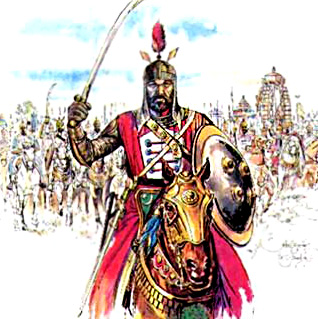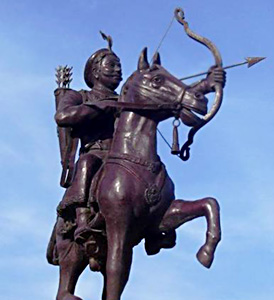 Several invasions were carried out by Muhammad Ghori, who was an ambitious ruler and the brother of Ghiyas-ud-din Muhammad. Muhammad Ghori wanted to expand his empire for power and glory. He was the governor and general under the Ghori dynasty. Unlike his elder brother, who tried to extend the empire towards the west, Muhammad Ghori, wanted to expand his empire towards the east. There are a series of invasion by Muhammad Ghori which led to the establishment of Turkish rule in India.
Several invasions were carried out by Muhammad Ghori, who was an ambitious ruler and the brother of Ghiyas-ud-din Muhammad. Muhammad Ghori wanted to expand his empire for power and glory. He was the governor and general under the Ghori dynasty. Unlike his elder brother, who tried to extend the empire towards the west, Muhammad Ghori, wanted to expand his empire towards the east. There are a series of invasion by Muhammad Ghori which led to the establishment of Turkish rule in India.
Muhammad Ghori first conquered part of Khorasan from the Seljuks and then began a series of campaigns in India. His first Indian expeditions were the foundations of Mohammedan rule in India. He reduced Sindh and Multan in the course of two expeditions and even made an unsuccessful attack on Bhima Deva Chalukya of Gujarat. He had already got possession of Peshawar and Punjab and the whole of Sindh down to the seacoast. Thereafter, he acquired and strengthened the fort of Sialkot and lastly he defeated and captured Khushru Malik, the last member of the house of Ghazni. Thus, Ghori dynasty became the lords of the Punjab. Muhammad Ghori now possessed the whole line of the Indus River down to the sea. Then he started strengthening his Indian base and prepared his eastern frontier town of Sirhind. He had got rid himself of all Muslim rivals, had reorganised his forces and could now face the Rajputs of Hindustan.
Muhammad Ghori`s preparations alarmed the great Prithviraj Chauhan, the ruler of Delhi and Ajmer. At that time, the most powerful of Rajputanas were Jai Chandra of Kanauj and Prithviraj of Delhi but their jealousy and mutual hatred prevented them from offering a united resistance to the invader. Muhammad Ghori had his first battle with Prithviraj in 1191 AD. In this first invasion, Ghori confronted Prithviraj at Tarain near Thaneswar. In this battle, the Hindu chief was assisted by his Rajputs brothers his rival of Kanauj. Ghori himself was wounded in this battle and had to be carried away from the field. The Muslim army broke away in a panic and was pursued for forty miles by the winners. The Rajputs besieged Sirhind and, after a long blockade, got favourable terms from the garrison.
 Muhammad Ghori returned with even a larger army in the next year in 1992 AD. He met with the opposition Prithviraj as the head of a large Rajput alliance and with numerous horses and elephants. But Prithviraj was defeated in this battle. The fall of Prithviraj was adopted as a tactics by the Mohammedans and made the Hindus feel suddenly assaulted and they started to think that they were fleeing from the field. Samarsi of Chitor, the brother-in-law of Prithviraj and known for his wisdom and bravery, and Govind Rai, his brother, were both slain. Prithviraj himself fled from the field, but was taken back and miserably executed. The victory was followed by the quick reduction of Samana, Hansi and other places in the neighbourhood.
Muhammad Ghori returned with even a larger army in the next year in 1992 AD. He met with the opposition Prithviraj as the head of a large Rajput alliance and with numerous horses and elephants. But Prithviraj was defeated in this battle. The fall of Prithviraj was adopted as a tactics by the Mohammedans and made the Hindus feel suddenly assaulted and they started to think that they were fleeing from the field. Samarsi of Chitor, the brother-in-law of Prithviraj and known for his wisdom and bravery, and Govind Rai, his brother, were both slain. Prithviraj himself fled from the field, but was taken back and miserably executed. The victory was followed by the quick reduction of Samana, Hansi and other places in the neighbourhood.
Muhammad Ghori then captured Ajmer which was the chief capital of the enemy and gave it to the charge of a natural son of Prithvi Raj on condition of his paying tribute. He returned to Ghazni leaving his favourite slave, Qutub-Ud-Din Aibak, in charge of the Conquest of Ajmer. The latter quickly captured Meerut, Aligarh and Delhi, the last of which he made his head-quarters. Shortly afterwards he extinguished Hindu rule in Ajmer and annexed it permanently to the Muslim dominion.
The next target of Muhammad Ghori became Kanauj. He attacked Kanauj in 1193 and perished the Ganges. The king Jai Chandra was defeated near Chandwar. Then Ghori advanced to Varanasi which was the second capital of the Gaharwars and destroyed its temples. According to the Mohammedan chroniclers, all the country up to Varanasi was captured and all the Hindu coins were re struck with the name of the conqueror.
 Muhammad Ghori made Qutub-Ud-Din the viceroy of his all his conquests in Hindustan as he was a very capable ruler. In the meantime, a Turkish-Afghan adventurer in the service of Muhammad Ghori, by name Muhammad Bin Bakhtiyar Khilji, who had gained fame under Qutub-Ud-Din, attacked Bihar in 1197 A.D. He rooted out easily the Pala dynasty and collapsed the Buddhism that had its stronghold there. This expedition continued up to Bengal and attacked the aged Rai Lakshmana Sena of Gaur at his capital, Nuddea (Navadwipa). Muhammad destroyed Nuddea, the home of Sanskrit learning, and made Lakhnauti his capital in 1199 AD. Muhammad Ghori thought of extending his arms to the region of the Himalayas but his attempt proved futile and he had to return after great loss.
Muhammad Ghori made Qutub-Ud-Din the viceroy of his all his conquests in Hindustan as he was a very capable ruler. In the meantime, a Turkish-Afghan adventurer in the service of Muhammad Ghori, by name Muhammad Bin Bakhtiyar Khilji, who had gained fame under Qutub-Ud-Din, attacked Bihar in 1197 A.D. He rooted out easily the Pala dynasty and collapsed the Buddhism that had its stronghold there. This expedition continued up to Bengal and attacked the aged Rai Lakshmana Sena of Gaur at his capital, Nuddea (Navadwipa). Muhammad destroyed Nuddea, the home of Sanskrit learning, and made Lakhnauti his capital in 1199 AD. Muhammad Ghori thought of extending his arms to the region of the Himalayas but his attempt proved futile and he had to return after great loss.
Muhammad Ghori desired to expand his kingdom in the west and invaded Khwarizm with a huge force but he sustained a disastrous defeat and had to escape with his life. Tajuddin Eldoz, a slave of Ghori who was in charge of Ghazni, shut its gates against his master. The defeat of Muhammad Ghori assumed independence. Qutub-Ud-Din remained steadfast and loyal and helped his master in recovering the leftovers. Muhammad Ghori was deceitfully murdered during his journey from Lahore to Afghanistan by a party of Khokhars in 1206 A.D. His dynasty could not survive long after him. The Turkish slaves who had served as generals under him assumed independence.
Muhammad Ghori was less fanatical than Sultan Mahmud. From the beginning he aimed at the building up of a permanent dominion and tried to consolidate his conquests under regular rule. He brought the fairest part of Hindustan under Muslim control and was the real creator of the Muslim rule in India. His work in India turned out to be solid and bore good fruit in the hands of Qutub-Ud-Din and his successors.
Muhammad Ghori charged Qutub-Ud-Din with the duty of extending the dominion of Islam in India and succeeded in founding a dynasty of rulers in Delhi. Muhammad Ghori had planned a permanent settlement and his scheme was successful in the hands of his general and successor, Qutub-Ud-Din.



















